Reflections On a Life Behind the Lens
Professor of Photography Klaus Schnitzer is profiled in Montclair Neighbors
Posted in: College News and Announcements, Department of Art and Design News
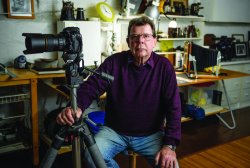
As a professional photographer, Montclair State University professor Klaus Schnitzer, is accustomed to finding himself in remarkably uncommon settings. From sit-ins and marches in the 1960s to a medical clinic in the heart of a Haitian slum, his images have captured a range of exceptional moments in time. “Having a press pass gave me access and a different perspective,” Klaus explained. “There’s a certain energy and it also challenged me to come up with something that’s unique.”
One of his many memorable photographic adventures began in the summer of 1982 when Professor Schnitzer challenged his advanced photography class with a “pressure assignment”, allowing them one week to prepare a photo essay of a chosen location. “For these assignments, we would go to places like the ferry terminal in Hoboken, the Bronx Zoo, the Staten Island Ferry,” he said. “Everybody would photograph the same thing in a limited time frame.”
For this particular class, Klaus arranged a tour of Ellis Island, which at the time had been completely abandoned since 1954 with only limited access to the public. “When we first got out there it was totally overgrown,” he recalled. “It was like being inside a jungle. And you’d sit on the edge and you’d have an incredible view of Manhattan.”
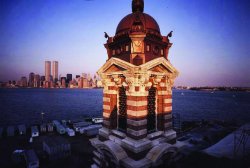
As it turned out, a single visit to the long forsaken iconic landmark proved to be insufficient to capture the vast array of nostalgia left behind. “We would open rooms that hadn’t been opened since 1954,” said Klaus. “There would be a newspaper and a dried up cup of coffee. And it looked like people just abandoned the island like someone had said, ‘You have to get off this island in the next hour.’ It was a strange place.”
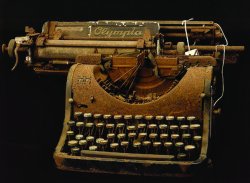
“They had everything there,” Klaus recalled. “A giant kitchen. A mattress sterilization unit. You had these huge hospital wings. People who were sick stayed out on the island and they had excellent medical facilities. If you were a young doctor assigned to Ellis Island it was fabulous because you would see diseases you wouldn’t see any other place.”
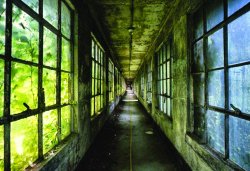
Knowing that the site was due for a major restoration, Klaus sent a proposal to the National Park Service. “I said, ‘Let me make you a deal. My students will photograph the renovation. You’ll have documentation in exchange for access to the island.’ And they accepted it.” But while Klaus had gained entrée and essentially free reign of the premises, he had yet to consider the logistics. “I thought, ‘Oh my god, how are we going to get there?’ because there was no bridge,” he explained. “So I was in a real pickle. But I found someone with an old boat in Hoboken. He would drop us off at the island and pick us up in the late afternoon. We did this three days a week.”
Year after year, Klaus’s students returned to the island to capture images of dusty artifacts and long-forgotten corridors. On occasion, despite the robust rat population, they even braved an overnight stay.
It’s been estimated that almost 40 percent of U.S. citizens can trace their ancestor’s entry point to Ellis Island. But for Klaus, the recollection of arriving in the United States as an immigrant isn’t a tale told by an older relative. The story is his own.
In 1957, at age thirteen, Klaus left his hometown of Niebüll, Germany along with his mother and younger brother to settle in upstate New York. “My mother was a widow. There weren’t many men left in her age group because of the war and there weren’t many work opportunities in the town we were in. But at forty to pack up and leave everything behind, including my older brother who was in trade school, took a lot of guts. My brother came a year later.”
Klaus and his family spent their first year in Oneonta, New York. “I found my classmates were extremely friendly. Considering the war wasn’t that far away. I was totally amazed. I was struggling with the language. I would teach them German and they would teach me English.”
After attending high school in Albany, New York, Klaus applied to community college with the hope of becoming an architect. “I realized I might be designing window frames for the rest of my life because every architect wants to be ‘the’ architect and I thought, ‘I don’t think that’s going to work out too well.’ So I transferred to SUNY Albany in 1964. I’ve always been interested in politics and social sciences so I was in the teacher program.” It was there that he began working for the school newspaper which was a powerful entity in a politically tumultuous time. “They handed me a Rolleiflex and had me cover a rally for Goldwater. I didn’t know what I was doing. It was a trial by fire but it came out okay.”
For two years between undergraduate and graduate school in the late sixties, Klaus had two university assistantships: one for the art department and one for publications. During this time, photography quickly became a passion for Klaus. He photographed everything from record covers and architecture to student protests and rock and roll concerts. “It was a really good time,” he said. “A group of us had a big apartment. We had a roommate who had a Volkswagen van and we’d go to the Newport Jazz Festival, racetracks and folk festivals.”
One particularly memorable excursion took Klaus to Rensselaer Polytechnic Institute where the Doors were performing. “I got some really nice photographs of Jim Morrison and when he was back up at Saratoga Performing Arts Center that summer I brought a bunch of pictures backstage and his manager said, ‘We like these pictures. Stay here.’ And Morrison comes from the dressing room and said, ‘You can go any place you want.’ “Klaus’s images earned him an enviable spot on stage. He described the moments he witnessed as he stood on the sidelines. “Morrison’s charisma was unbelievable,” he said. “He would put up his hand and the crowd would rush the stage and then he would put up his hand and they would all stop. The intensity. It was breathtaking.”
Being a photographer in the 1960s often placed Klaus front and center as history unfolded before him at student demonstrations on campus as well as national events like the March on the Pentagon. “There were huge crowds,” he recalled, referring to the Washington, D.C. event. “We marched towards the Pentagon and it got denser and denser. People were burning draft cards which was a criminal offense at that time. Once in a while, you would hear a roar and a soldier would drop his rifle and walk into the crowd.
A deserter. That took a lot of guts. The energy was unbelievable. But if I went to a demonstration today I wouldn’t be able to photograph as freely. As a journalist, you were never attacked or harassed. Nowadays with the polarization, it becomes much more difficult.”
Those historic demonstrations, as well as Klaus’s encounter with Jim Morrison, are among the many unique experiences his photographic career has afforded him. These days Klaus, who was once a racing instructor for the BMW club, spends much of his time behind the lens photographing cars for automotive magazine covers as well as writing about historic cars and collectors.
In February, as Klaus approaches his retirement from Montclair State University in the spring, many of the exceptional images he’s captured over five decades are set to be celebrated in a retrospective of his work, along with those of 50 of his former students and alumni of MSU. Many graduates who’ve benefited from Klaus’s guidance have gone on to have successful photographic careers of their own. “What I’ve done with my students is to help them to find their own voice,” he explained. “I really pushed them to look into themselves and do something that’s unique to their vision. Their concept.”
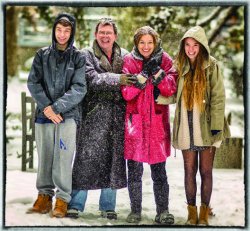
This piece was written by Candace Horowitz for Montclair Neighbors Magazine
